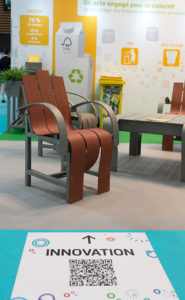Pollutec did not wait for the concept of the circular economy to showcase materials produced from recycling or from renewable sources (i.e. bio-sourced).
Recycling and recovery have been at the heart of the show for decades, bringing together the raw materials and energy economies, benefits for the climate (by reducing GHG emissions) and at the same time, improved economy through effective cost control and the deployment of ever more innovative technologies. Going well beyond paper, glass and metals, the recycling industry – now a sector of its own – is constantly developing new ways of obtaining recycled materials of ever-improving quality, relying on advances in sorting and separation of materials together with new processes. Pollutec captures all these developments, particularly in the Recycling Village created with FEDEREC in 2001.
The iconic food carton

The food carton, with its multi-layer packaging (paper, plastic, aluminium) is representative of the efforts made to find new outlets and increased performance from recycled materials. In 1998, an office furniture manufacturer introduced the first machinable panels made from food cartons. At Pollutec in 2012, plastics processor Acaplast, unveiled extruded sections made from these complex packaging materials.
And in 2016, Alliance Carton Nature confirmed the added value of this resource, with Urban’Ext, presenting PolyAl, an unorthodox material, well suited to use in street furniture because of its unique properties of impermeability and resistance to impact, UV and graffiti.
Ocean-sourced materials
With the Monashell odour bio-filter, based on oyster and mussel shells, in 2009 Pollutec opened the way to wider acceptance of eco-materials using ocean-sourced waste. Since 2000, Prosign (Colas group) has been committed to the development of its eco road paints, and is also presenting at the show its Ostrea road-markings material which incorporate crushed oyster shells for increased whiteness. Algo paints, based on algae and oysters, predominated in 2015, while in 2014 fish leather from start-up Femer made its first appearance. Today, the sea products sector is flourishing, with many other practical applications emerging.
According to a 2017 Ademe/FEDEREC study, recycling waste could lead to a 5% reduction in annual CO2 emissions, equivalent to 18 nuclear power stations.
3D printing filament made from cups
Having presented collecting bins for disposable cups and cans several times at the show, Canibal (Buy&Care prize, 2010) has pursued this to its logical conclusion by working on possible outlets for mixed material cups which have no processing stream. In 2012, the start-up debuted Caniplac, a material made from 50% cups with a limestone mineral material, which can be used to produce tiles or partitions. On the same technical basis, further work in 2017 led it to the development of a 3D printing filament which was used to produce prosthetics for hands.
Recycled plastics and bioplastics
Eco-materials are currently displaying two major trends in the plastics sector. The first is increased added value recycling, or having outlets in complex manufacturing streams, and the second is bio-sourced materials. Numerous innovations have demonstrated these two approaches at Pollutec: from recycled PET, approved for food use in 1997, to Pévéchouc in 2006, made from PVC waste and recycled textiles, and for bio-sourced plastics, innovations from Arkema, the water-soluble plastic made from milk proteins by Lactip (in 2016) and the bio-sourced composites from Apollor (in 2007) or Certech in 2011.
The innovations of Pollutec 2018 related to eco-materials
Cycl’Add : Ecological plastic boosters from recycling
Deltalys : Eco-efficient solution for biogas purification
Hymag’In : Recycling and upgrading of ferrous waste and byproducts into magnetite
Materr’Up : Low carbon structural concrete made from clay or excavated material
Suez : Treated polluted soil re-used in alternative materials